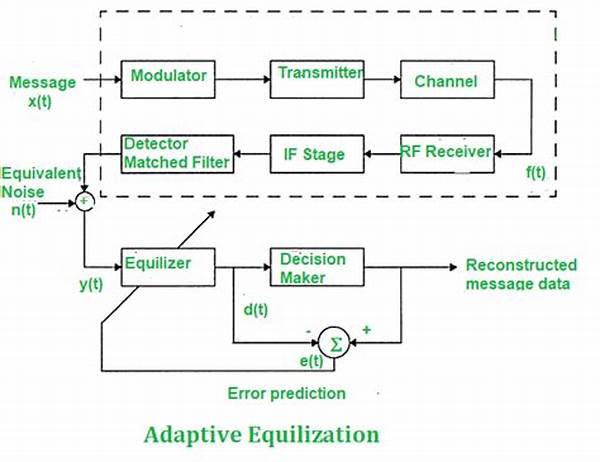In the rapidly advancing realm of wireless communications, adaptive wireless communication systems have emerged as a vital solution to meet the ever-growing demands for speed, efficiency, and reliability. These systems are exceptionally designed to adapt to varying conditions, ensuring optimal performance in diverse environments. They are pivotal in the era of 5G and beyond, where flexibility and scalability are paramount. As technological advancements continue to reshape communication landscapes, understanding the nuances of adaptive wireless communication systems is crucial for researchers, engineers, and industry professionals alike.
The Importance of Adaptive Wireless Communication Systems
Adaptive wireless communication systems serve as the backbone of modern telecommunication networks. They possess the unique ability to adjust their parameters in real-time in response to changing spatial, temporal, and spectral conditions. This adaptability ensures seamless connectivity and high data rates, thereby enhancing the quality of service.
By dynamically modifying modulation schemes, transmission power, and frequency allocations, adaptive wireless communication systems optimize the use of available resources. These systems are paramount in overcoming challenges such as interference and network congestion, which are prevalent issues in densely populated urban areas. Consequently, they play a significant role in ensuring reliable communication, even in the face of unpredictable and fluctuating conditions.
The development and implementation of adaptive wireless communication systems are driven by the need to accommodate an increasing number of users and devices. They enable the integration of diverse technologies, fostering a harmonious coexistence of multiple communication standards. As such, these systems are instrumental in supporting emerging applications, ranging from IoT to autonomous vehicles, which necessitate high-performance and adaptive communication solutions.
Characteristics of Adaptive Wireless Communication Systems
1. Dynamic Modulation Adjustment: Adaptive wireless communication systems dynamically modify modulation schemes to optimize data throughput and signal integrity, adapting seamlessly to varying channel conditions.
2. Real-Time Spectrum Management: These systems implement real-time spectrum management strategies, efficiently allocating frequency resources to contend with interference and enhance spectral efficiency.
3. Intelligent Power Control: Through adaptive power control mechanisms, wireless systems efficiently manage transmission power, balancing energy consumption with performance requirements to optimize connectivity.
4. Multi-Antenna Configuration: Advanced antenna technologies, such as MIMO systems, are employed to exploit spatial diversity, improving link robustness and system capacity.
5. Environment-Aware Adaptability: Adaptive systems possess environment-aware capabilities, enabling them to respond dynamically to external changes and maintain optimal communication performance.
Technological Advancements in Adaptive Wireless Communication Systems
Recent technological advancements have propelled adaptive wireless communication systems into the forefront of telecommunication innovations. The integration of machine learning and artificial intelligence is transforming the way these systems operate, enabling them to predict and respond to environmental fluctuations with unprecedented precision. The application of AI in network management facilitates real-time decision-making processes, optimizing resource allocation effectively.
Furthermore, adaptive wireless communication systems are increasingly incorporating cognitive radio technology. Cognitive radios empower networks with the ability to sense their surroundings, autonomously identifying unused frequency bands, and adapting transmission parameters for maximum efficiency. This fosters spectrum sharing and resource optimization, crucial for the expansive growth of wireless services.
Emerging technologies such as beamforming are also playing a pivotal role in enhancing the performance of adaptive wireless communication systems. By focusing signal energy in specific directions, beamforming improves signal strength and reduces interference. This advancement is particularly essential for deploying high-frequency bands in 5G networks, ensuring extensive coverage and exemplary service quality.
Challenges Faced by Adaptive Wireless Communication Systems
1. Interference Mitigation: Adaptive wireless communication systems must effectively manage interference, a persistent challenge compromising signal quality and reliability.
2. Dynamic Resource Allocation: Efficiently allocating resources in real-time remains challenging as systems contend with variable user demands and fluctuating network conditions.
3. Scalability Constraints: Adapting to a growing number of devices while maintaining optimal performance underscores a significant scalability issue in system design.
4. Security Vulnerabilities: Ensuring robust security measures to protect adaptive systems from evolving cyber threats demands ongoing innovation and vigilance.
5. Network Latency Reduction: Minimizing latency in adaptive wireless communication systems is essential for real-time applications that require instantaneous data exchange.
Future Prospects for Adaptive Wireless Communication Systems
Looking forward, the future of adaptive wireless communication systems is exceedingly promising. These systems will continue to evolve, incorporating cutting-edge technologies to meet the demands of an increasingly connected world. Upcoming advancements in 6G technology are expected to further enhance the capabilities of these systems, providing vast improvements in speed, latency, and network capacity.
Additionally, the proliferation of IoT devices and the advent of smart cities will drive the evolution of adaptive wireless communication systems towards greater efficiency and ubiquitous connectivity. The integration of more sophisticated AI algorithms will facilitate seamless network management, improving the adaptability and intelligence of these systems significantly.
In summary, adaptive wireless communication systems will remain integral to the advancement of global communication infrastructures. Their ability to dynamically respond to changing conditions ensures they are well-equipped to support an array of innovative applications and services, driving forward the next generation of wireless communication technology.
Conclusion on Adaptive Wireless Communication Systems
In conclusion, adaptive wireless communication systems represent a transformative advancement in the field of telecommunications. These systems are at the forefront of harnessing the complexity and dynamism inherent to modern communication demands. By adapting to environmental and network changes in real-time, they ensure consistently high performance and reliable connectivity.
The implementation and continuous evolution of adaptive wireless communication systems will play a pivotal role in supporting future technological innovations. Their integration with emerging technologies such as AI, cognitive radio, and beamforming will propel them into new realms of capability and efficiency, ultimately shaping the future of global communication networks. As the digital landscape continues to evolve, these systems are poised to deliver unparalleled communication experiences, catering to both current and unforeseen demands.





